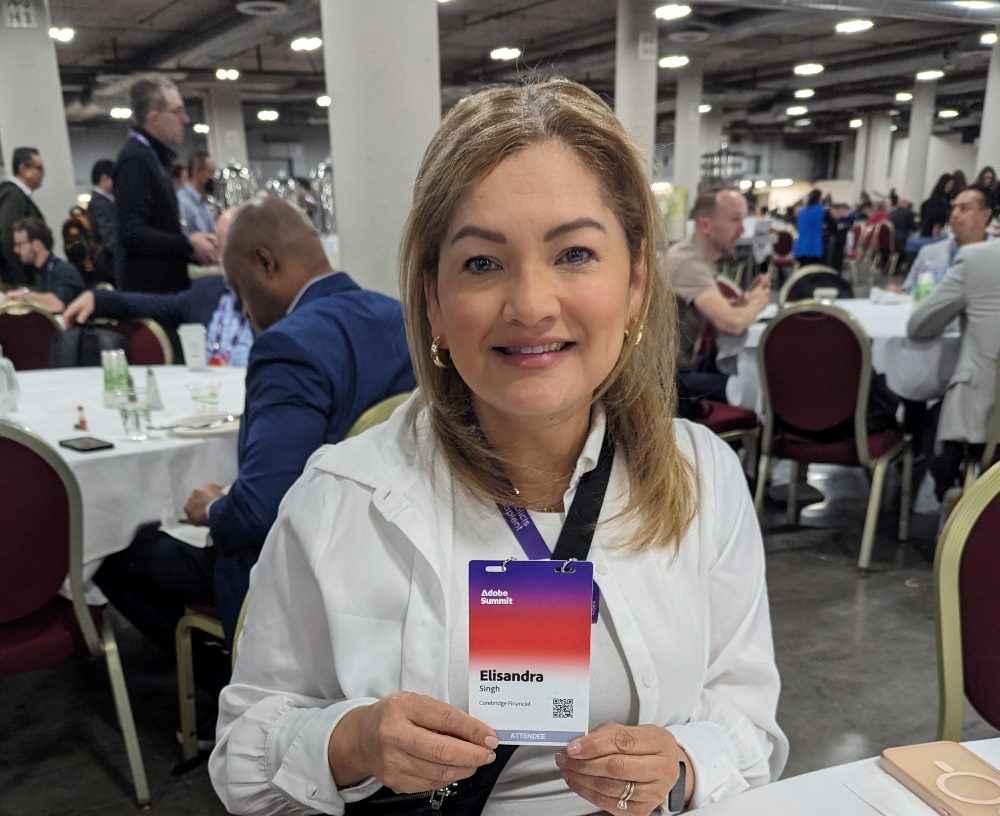The Gist
- Generative AI’s impact on content creation. Marketers like Crystal Flores from Gigamon are leveraging AI to produce content that balances quality with quantity, despite concerns about potential Google penalties for AI-generated content.
- Personalized communications through AI. Erin Mahan of the American Red Cross and other marketing leaders are exploring generative AI to create more personalized and engaging donor communications.
- Challenges in AI adoption for financial services. Elisandra Singh from AIG Retirement Services discusses the hurdles of integrating AI in financial marketing, emphasizing the need for compliance and security.
LAS VEGAS — Adobe’s spent a good chunk of its stage time here this week at the Adobe Summit at the Venetian touting its generative AI marketing innovations in its digital customer experience software stack.
And why not? The numbers are enticing.
McKinsey estimates that marketers could net along with other departments 75% of up to $4.4 trillion in annual global productivity.
I’ll have what those marketers are having, right? Well, there are aspirations. And then reality.
A quick sweep on the Adobe Summit floor beyond the fancy keynote demos, on-point cuisine and glowing casino lights in this desert lies a different narrative: it’s still early days for some marketing practitioners when it comes to practical applications of generative AI in marketing. Many marketers, while sneaking a peek, are walking right past the generative AI blackjack table — for now.
We caught up with a few marketing leaders here this week to share their generative AI in marketing tales:
SEO and Content Marketing: Balancing Innovation With Quality
Crystal Flores, senior digital marketing manager, Gigamon, is all in on the value of using AI-generated content to increase quantity and quality. However, she’s got concerns using AI to generate blog content, worrying about Google’s response and getting dinged for relying on AI content.
Crystal Flores, senior digital marketing manager, GigamonDom Nicastro
For sure, her marketing teams get reassurance and new ideas for SEO best practices through generative AI, but that doesn’t always mean the content will rank well. (See? Even AI can’t figure out Google’s algorithms sometimes).
And despite generative AI having the capability to produce a large volume of content, Flores noted the need to diversify content strategies.
“I’m nervous to use it for that reason because I figure Google’s going to realize that it’s an AI-generated blog and ding us later,” she said. “So even though I’m pumping out (content) — because I have limited resources on my team in terms of creating content — (generative AI) allows me to get it out there, but I’m also realizing I can’t put all my eggs in one basket. I need to diversify what I’m putting out there.”
Flores also discussed a balancing act between producing a high quantity of content and ensuring it meets quality standards that genuinely serve customer needs. When content truly meets customer needs and is perceived as being written by a real human, it tends to rank better, she said.
Content generation being the main use currently for generative AI, Flores said her marketing teams are also exploring generative AI for analyzing customer journeys and customer data to improve marketing strategies. This includes looking into AI tools for enhancing customer experience and engagement.
Flores is also paying close attention to ethical and legal implications of exploring generative AI implementations into marketing, such as ensuring legal compliance when using AI-generated assets.
Related Article: Sam Altman: AI Will Replace 95% of Creative Marketing Work
The Quest for Personalized Customer Communications
Erin Mahan, manager, marketing operations for the American Red Cross, emphasized the importance of personalizing communication with blood donors through multimedia content such as videos and infographics. Her marketing teams are starting to think about where generative AI can help those efforts.
View all Erin Mahan, manager, marketing operations, American Red Cross Dom Nicastro
Her organization is relatively new to Adobe products. They primarily use Adobe Campaign for omni-channel marketing, including direct mail and text messaging through partners.
Despite an interest in expanding their use of AI and Adobe products, budget constraints limit their ability to adopt new technologies. The organization is exploring ways to effectively use their resources to enhance their marketing efforts, starting with managing shared assets and improving collaboration across different teams. Adobe Workfront is being considered as a potential solution.
Communication channels are chosen based on the preferences of each demographic, recognizing, for example, that younger audiences may prefer text messages or app notifications.
While the use of AI is attractive, the organization is cautious about diving in without fully understanding its implications and benefits. It’s attractive, she said that AI can assist in content creation and analysis, suggesting potential areas for future exploration.
“In terms of AI, the interest is there,” Mahan told CMSWire, “budget is not necessarily. So right now we’re just trying to explore what’s the priority for us as a nonprofit. What can we do with a little bit? What can we make bigger? So right now we’re just seeing if there’s an additional Adobe product that we can leverage to just get started. I think one of the big things for us is looking at how to better manage shared assets, starting there. And then getting our different partners out of silos.”
Related Article: Generative AI in Marketing: Smoothing Creative Operations
The Intersection of AI and Customer Experience in Financial Services
Elisandra Singh, director, digital strategy at AIG Retirement Services, shared some real challenges of implementing AI in her marketing operations for her organization.
 Elisandra Singh, director, digital strategy, AIG Retirement Services.Dom Nicastro
Elisandra Singh, director, digital strategy, AIG Retirement Services.Dom Nicastro
Her company is currently not utilizing AI extensively but is in the research phase. They aim to understand how AI can interconnect with Adobe products they use, such as Adobe Experience Manager, Adobe Analytics and Adobe Target, among others. The main goal is to explore the possibilities AI offers for enhancing their marketing and customer experience.
A significant hurdle to implementing AI is the legal and compliance considerations, especially concerning customer data security and privacy. Being a financial company, they face heightened scrutiny and must ensure that any adoption of AI does not compromise customer data privacy or security.
“We want to be able to see all the possibilities,” Singh said, adding, “and we want to see how AI is going to be interconnected with (Adobe). How do we realize that? There are a lot of things we want to do, but we can’t do them quite yet because we have legal compliance, and we have to understand, first of all, how the AI world works. We can’t just do whatever you want, and just put it out there, especially being a financial company. It’s a lot of security risk.”
Essentially, marketers in financial services like Singh are practicing a cautious but optimistic approach toward AI, focusing on improving customer engagement and personalization while navigating the complex regulatory landscape of the financial industry. Singh’s vision for the future includes creating an intuitive and predictive online experience that anticipates user needs, driven by insights from AI and analytics.
The ultimate end goal? Anticipating customer needs through solid customer data and experience analytics.
“We have to think about the end customer,” Singh said. “We have to say if somebody’s looking for this, I want to be able to give it to them before they even start looking through it. Who are they? What are they doing? I want to be able to know that.”




